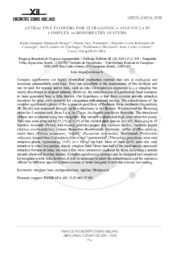Attractive flowers for Tetragonisca angustula in complex agroforestry systems.
Attractive flowers for Tetragonisca angustula in complex agroforestry systems.
Autoria: MALAGODI-BRAGA, K. S.; WATANABE, M. A.; CAMARGO, R. C. R. de; QUEIROGA, J. L. de; MORICONI, W.; CANUTO, J. C.
Resumo: Complex agroforestry are highly diversified production systems that aim at ecological and economic sustainability over time. They can contribute to the maintenance of bee diversity and can be used for rearing native bees, such as jataí (Tetragonisca angustula L.), a stingless bee widely distributed in tropical habitats. However, the attractiveness of agroforestry food resources to these generalist bees is little known. Our hypothesis is that these systems provide attractive resources for jataí, with potential for integration with rational rearing. The attractiveness of the complex agroforestry plants of the Agroecological farm of Embrapa Meio Ambiente (Jaguariúna, SP, Brazil) was measured through the bee abundance in the flowers. We observed the flowering plants for 5 minutes each, from 8 a.m. to 12 a.m., in climatic conditions favorable. The abundance of bees was evaluated using two categories: low (attractive plant) and high (very attractive plant). Jataí bees were attracted by 52,2 % (n = 35) of the studied plant species (n = 67), belonging to 18 families. Avocado (Persea Americana), peruvian pepper tree (Schinus molles), brazilian pepper (Schinus terebinthifolius), chinese flame-tree (Koelreuteria bipinnata), coffee (Coffea arabica), castor bean (Ricinus communis), ?murici? (Byrsonima intermedia), Brazilwood (Paubrasilia echinata), leopard tree (Caesalpinia ferrea) and ?quaresmeira? (Tibouchina granulosa) were very attractive plants, representing 14.9% (n = 10) of the total. Most of them (n=7) were also very attractive to other bee species, mainly stingless bees. More than half of the plant species presented attractive flowers to Jataí, but only a few were intensively explored by them, following a pattern already observed in other studies. Complex agroforestry systems can be designed and improved for integration with bees; however, it will be necessary to know the attractiveness and the resources offered by different species in these systems to better integrate it with the rational bee rearing.
Ano de publicação: 2018
Tipo de publicação: Resumo em anais e proceedings
Unidade: Embrapa Meio Ambiente
Palavras-chave: Apidae, Meliponiculture, Meliponini, Sistema agroflorestal, Stingless bees, Tetragonisca Angustula
Observações
1 - Por padrão são exibidas publicações dos últimos 20 anos. Para encontrar publicações mais antigas, configure o filtro ano de publicação, colocando o ano a partir do qual você deseja encontrar publicações. O filtro está na coluna da esquerda na busca acima.
2 - Para ler algumas publicações da Embrapa (apenas as que estão em formato ePub), é necessário ter, no celular ou computador, um desses softwares gratuitos. Sistemas Android: Google Play Livros; IOS: iBooks; Windows e Linux: software Calibre.
Acesse outras publicações
Acesse a Base de Dados da Pesquisa Agropecuária (BDPA) para consultar o acervo completo das bibliotecas da Embrapa.

